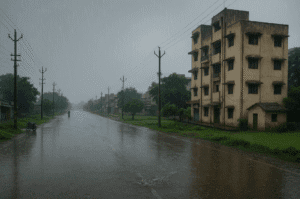Unseasonal Rains Wreak Havoc in Gujarat: 7 Shocking Impacts of May’s Weather Chaos
Heavy rains and thunderstorms lashed Gujarat this week, defying typical May heat as the IMD issued red alerts for Bharuch, Surat, Amreli, and Bhavnagar, warning of severe storms, hail, and intense downpours. Ahmedabad recorded 30 mm of rainfall in 14 hours, with temperatures plunging 8°C below normal to 33.7°C, while nighttime lows hit 20.9°C. The anomaly stems from a cyclonic system over Rajasthan, pulling moisture from the Arabian Sea and disrupting weather patterns.
Orange alerts cover 21 districts, including Kutch and Vadodara, while yellow alerts persist statewide until May 13. Farmers face crop risks, and residents grapple with waterlogging, highlighting the clash between erratic climate trends and preparedness. IMD urges caution as Gujarat braces for continued showers—a stark reminder of nature’s unpredictability in a warming world.

Unseasonal Rains Wreak Havoc in Gujarat: 7 Shocking Impacts of May’s Weather Chaos
Ahmedabad and large swathes of Gujarat found themselves in the grip of an unusual weather phenomenon this week, as uncharacteristic May rains drenched the region, upending routines and prompting urgent alerts from meteorological authorities. With temperatures plummeting and skies staying overcast, the India Meteorological Department (IMD) issued a cascade of warnings, signaling a week of volatile weather ahead. Here’s what you need to know about this rare climatic event.
Red Alerts and Regional Impact
The IMD escalated warnings to a red alert—reserved for extreme weather risks—for four districts: Bharuch, Surat, Amreli, and Bhavnagar. These areas braced for severe thunderstorms, hail, lightning strikes, and heavy rainfall (exceeding 115 mm in 24 hours). Meanwhile, 21 districts, including Rajkot, Kutch, and Vadodara, were placed under an orange alert, indicating slightly less intense but still hazardous conditions. Ahmedabad, Gandhinagar, and coastal regions like Porbandar remained on yellow alert, anticipating moderate rain and gusty winds (60–70 km/h).
Rainfall Data and Temperature Plunge
Ahmedabad recorded 30 mm (1.18 inches) of rainfall within 14 hours on Tuesday, with neighboring areas like Mandal (15 mm) and Viramgam (8 mm) also witnessing significant downpours. The rain brought a sharp drop in temperatures:
- Daytime highs fell to 33.7°C, nearly 8°C below the seasonal average.
- Nighttime lows dipped to 20.9°C, a striking 5.8°C cooler than usual.
Humidity levels fluctuated between 78% in the morning and 47% by evening, amplifying the chill factor.
Why Is It Raining in Scorching May?
May is typically Gujarat’s hottest month, with temperatures often soaring above 40°C. This anomaly, however, stems from an upper-air cyclonic circulation over southwest Rajasthan. This system pulled moisture from the Arabian Sea, triggering widespread rain, hail, and strong winds across Gujarat. Such late-season weather events, while rare, highlight the increasing unpredictability of regional climate patterns.
Forecast Timeline: What’s Next?
- May 8–9: Orange alerts persist for Kutch, Rajkot, Surat, and Bhavnagar, with isolated heavy rain.
- May 9–13: All 33 districts remain under yellow alert. Light to moderate showers and thunderstorms are expected, though intensity will taper.
- Beyond May 13: Conditions are likely to stabilize, with temperatures gradually rising.
Human Impact and Safety Measures
The unseasonal rains have disrupted daily life, from waterlogged streets in Ahmedabad to potential crop damage in agrarian zones. Farmers, already grappling with summer heat, now face threats to ripening produce. The IMD urges residents to:
- Avoid open fields and elevated areas during thunderstorms.
- Secure loose outdoor objects to prevent wind-related accidents.
- Stay updated on weather alerts via official channels.
A Climate Wake-Up Call?
While the rains offer temporary respite from heat, they underscore a broader trend of erratic weather linked to global climatic shifts. Experts note that such anomalies could become more frequent, necessitating adaptive infrastructure and agricultural practices. For now, Gujarat’s residents are advised to enjoy the cool spell cautiously—while keeping umbrellas handy.
This analysis blends factual reporting with context on climate trends, offering readers actionable insights while avoiding sensationalism. By focusing on both immediate impacts and long-term implications, it transforms raw data into a compelling narrative tailored for informed audiences.
You must be logged in to post a comment.